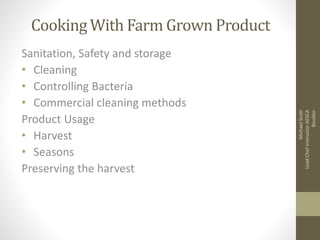
Cooking with farm grown product
- 1. Cooking With Farm Grown Product Sanitation, Safety and storage • Cleaning • Controlling Bacteria • Commercial cleaning methods Product Usage • Harvest • Seasons Preserving the harvest Michael Scott Lead Chef Instructor AESCA Boulder
- 2. “Dinner in the Field” Dinner Zephyros Farm 2008 The First Culinary Educational Farm to Table Dinner in the World Michael Scott Lead Chef Instructor AESCA Boulder
- 3. Receiving product • Clean excessive dirt, dry and store product for later use • Excessive water will cause mold and rotting • Cut tops from root vegetables • Root vegetables will lose nutrients and wilt if stored with tops on • Tops may by used for additional applications • Refresh wilting greens in tepid water • Make a fresh cut on the stem so water can be absorbed • Remove excess water for longer storage • Store vegetables according to type: most vegetables prefer dry, cool to cold temperatures and dark. • Cover to prevent wilting in refrigeration Michael Scott Lead Chef Instructor AESCA Boulder
- 4. Late Harvest Bounty Michael Scott Lead Chef Instructor AESCA Boulder
- 5. Controlling Bacteria Prior to processing and production of product soak all garden vegetables in an alkaline solution. • 2 Tablespoons Baking soda & 2 Tablespoons salt in a 5 gallon bucket of water filled to 4 gallons • Soak product for 15 minutes • Rinse all product in fresh water to remove alkaline residue Avoid storing low acid vegetables in an anaerobic environment (no oxygen) to avoid botulism. • Garlic in oil even after roasted should be stored under refrigeration. • When processing tomatoes add lemon juice to ensure a pH of at least 4.6. Michael Scott Lead Chef Instructor AESCA Boulder
- 6. Conventional Methods for Cleaning Vegetables • Organic vegetables sold in grocery stores and supermarkets are soaked in a 5% bleach solution. • Conventional vegetables grown with pesticides and chemicals are not always washed to remove these poisons. • Additional waxes and preservatives may be added. Dirty Dozen conventional vegetables to avoid • Apples, celery, cherry tomatoes, cucumbers • Grapes, hot peppers, imported nectarines, peaches • Potatoes, strawberries, spinach Michael Scott Lead Chef Instructor AESCA Boulder
- 7. Old World Cooking Reclaimed Wild Game Livestock Head to Hoof Cooking Artisan Practices Wild Yeasted Breads Cheese making Winemaking Preserving Pickling Michael Scott Lead Chef Instructor AESCA Boulder
- 8. Seasonal cooking & utilizing storage crops Seasonal crops • Plan menus around what is being harvested • Vary preparations for diversity • Utilize vegetables at different stages of growth i.e. pea shoots • Adapt to abundant harvest i.e. zucchini Storage crops • Utilize the stored crops from the previous season • Plan harvesting to maximize product availability • Sun chokes can be harvested in the fall or the spring • Harvesting in the spring when other crops are less abundant is more efficient Michael Scott Lead Chef Instructor AESCA Boulder
- 9. Michael Scott Lead Chef Instructor AESCA Boulder
- 10. Food Preservation Methods Canning & pickling • Boiling water bath canning • High acid foods with a pH 4.6 or lower • Addition of acid for low acid foods • Pressure canning • Low acid foods • Utilizes pressure to obtain higher temperatures Fermenting • Fermenting crock • Salt, whey or starter culture • Increases nutrients in food • Unlocks essential nutrients Michael Scott Lead Chef Instructor AESCA Boulder
- 11. Preserving the Harvest Drying Food • Sun dried • Food dryers • Dehydrators Harvesting Seeds • Legumes • Dry on the vine, remove pods and store • Retain some of harvest for nest seasons crop • Be careful of plants that cross polinate • Grains Michael Scott Lead Chef Instructor AESCA Boulder
- 12. Additional resources can be found at the bottom of the syllabus page Michael Scott Lead Chef Instructor AESCA Boulder
